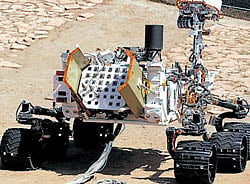Hours before the much-awaited touch down of NASA’s car-sized rover Curiosity on the Martian surface, an Indian scientist who identified the landing site, is keeping his fingers crossed.
Amitabh Ghosh, chair of the science operations working group at NASA Mars Exploration Rover Mission, was a key member of the team that zeroed in on the Gale crater location where Curiosity will land after flying more than 350 million miles in the last eight months.
“The best engineers have worked on missions. But Mars remains an unknown frontier. Until the rover lands successfully, you never know. The chances of toppling of the rover, however, are very low,” Ghosh told Deccan Herald.
Gale Crater was chosen as the landing site because it is a place with sedimentary layers. Each layer records the conditions during a particular geologic epoch. Some layers contain clay minerals, according to remote sensing data sent back by the Mars Reconnaisance Orbiter; and will help recreate the paleoenvironment on Mars.
Expected to touch down on Monday, Curiosity is the most sophisticated exploration vehicle that ever visited Mars. It is designed to survey the Martian landscape, analyse the rocks and search for signatures of water under the Martian surface.
Two times larger and five times heavier than old-generation Mars rovers Spirit and Opportunity, Curiosity rivals a small SUV in size and carries 15 times the weight of the scientific instruments that Spirit and Opportunity have.
Ghosh, who was associated with the 1997 Pathfinder mission also, said one of the old rovers is still sending scientific data.
Spirit and Opportunity landed on Mars in 2004. Opportunity is still going strong. Opportunity survived her fourth Martian winter (one Martian year is equivalent to two years on the earth) and at present has descended into Endeavour Crater where it still driving on the Red Planet to continue with its science campaign. The second rover, Spirit stopped communicating with the Earth in 2010.
Ghosh is not the only scientist of Indian origin involved with NASA’s most ambitious mission to the Mars.
Anita Sengupta, a senior systems engineer at NASA’s Jet Propulsion Laboratory (JPL), played an instrumental role in the much talked about EDL – entry, descent and landing – sequence, which has been dubbed as “seven minutes of terror,” by engineers. A space crane will be deployed for the first time to gently lower the rover on the Mars. If everything goes according to the plan, six wheels of the rover will sink in the red soil and begin to transmit images within hours.
A dust storm in southern Mars being monitored by NASA’s Mars Reconnaissance Orbiter appears to be dissipating. “Mars is cooperating by providing good weather for landing,” said JPL’s Ashwin Vasavada, another researcher of Indian origin who is the deputy project scientist for Curiosity.
Curiosity was approaching Mars at about 3,600 metres per second Saturday morning. By the time the spacecraft hits the top of Mars’ atmosphere, seven minutes before touchdown, gravity will accelerate it to about 5,900 metres per second.
Curiosity will investigate whether Mars has ever offered environmental conditions favourable for microbial life, including chemical ingredients for life.

